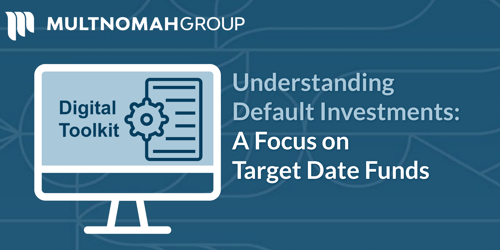Target date funds (TDFs) are one of four qualified default investment alternatives (QDIA) provided under the 2006 Pension Protection Act (PPA). Over the past decade, plan fiduciaries have made TDFs the default of defaults for plan participants. These individual decisions by plan fiduciaries have skyrocketed the growth of TDFs and have fundamentally changed how many Americans save for retirement.
In February of 2013, the Employee Benefits Security Administration (ESBA) from the Department of Labor (DOL) published, “Target Date Retirement Funds – Tips for ERISA Plan Fiduciaries.” Unlike the blizzard of disclosures the DOL has mandated, these straightforward guidelines provide a clear path towards doing the work of a good plan fiduciary.
-
Establish a process for comparing and selecting TDFs
It should go without saying that a fiduciary needs to have a process for selecting any investment product. It also seems reasonable that if a product is the plan default, that the scrutiny is more important, not less. The process should include fund specific information (e.g. past performance, fees, glidepath, etc.) but also how the participant demographics align with the TDFs investment philosophy. -
Establish a process for the periodic review of selected TDFs
Defined contribution plans rarely work when fiduciaries “set it and forget it.” Having a process for evaluating the success of the target date suite you selected can be challenging, but it is reasonable.
Common elements of a TDF review include –
- Has anything in your initial analysis changed? (Plan demographics or plan design? Target date fund series?)
- Is the fund behaving consistent with expectations given the market environment?
- If the TDFs are actively managed, are the portfolio managers adding value?
- How do these products compare to available alternatives (peer group analysis)?
- Are the participants using the options appropriately? -
Understand the funds’ investments
Most TDFs are made up of other investment products. It is not possible to understand the whole picture without understanding the structural pieces and asset allocation glidepath that determine its performance. Have a good understanding of what your target date fund is doing and how it goes about doing it. -
Review the funds’ fees and investment expenses
Going all the way back to 1996, the DOL has been focused on the cost of investing for participants. TDFs are often the default investment for participants who fail to make their own investment election. Managing the costs paid by these participants who have not actively-picked their investment allocation is important. Fiduciaries should ensure they are monitoring the total investment costs and understand if fees are charged by the portfolio manager for asset allocation overlay services (this practice is less common than in the early days of TDFs) -
Inquire about whether a custom or non-proprietary TDF would be a better fit for your plan
Knowing that the DOL wants you to have a process for comparing and selecting target date funds, the determining factor should not be, “it’s what my recordkeeping vendor offered me.” If you elect to use a product developed by your recordkeeping vendor, do so only after careful consideration of other alternatives, even the alternative of changing recordkeepers if necessary. -
Develop effective employee communications
If the DOL is concerned that plan sponsors do not yet know how TDFs work, you can only imagine the gaps at the participant level. There is good evidence emerging that for the least sophisticated participants, target date investments provide better returns than participants left to their own devices. However, the DOL wants efforts to be made to ensure participants understand the risks that come with investing in TDFs. -
Take advantage of available sources of information to evaluate recommendations you received regarding the TDF selection
Was the recommendation independent? Did it come from a fiduciary? Were your questions adequately answered? Plan sponsors are understandably eager for the assistance of experts, but also need to push back and have their questions answered adequately. -
Document the process
Without a proper documentation trail, it’s like there was no process at all. It is clear that the DOL likes to see fiduciaries “show their work” when it comes to meeting their selection and oversight responsibilities.
For a printable version of the DOL's 8 Guidelines, click the button below.

Interested in learning more about default investments? Our latest toolkit is focused on helping plan sponsors understand what default investment options are available and why target date funds are the most popular.
Multnomah Group is a registered investment adviser, registered with the Securities and Exchange Commission. Any information contained herein or on Multnomah Group’s website is provided for educational purposes only and does not intend to make an offer or solicitation for the sale or purchase of any specific securities, investments, or investment strategies. Investments involve risk and, unless otherwise stated, are not guaranteed. Multnomah Group does not provide legal or tax advice.



